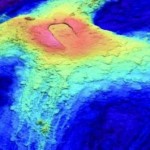Mount Sinabung—a 2,460-meter-high Indonesian stratovolcano which has erupted in 2010, 2013, and early 2014—kicked off October with ongoing magnificent eruptions, extruding viscous intermediate lava lobes which collapsed, sending break-neck speed pyroclastic flows as far as 3.5-4 km. Compare this Pelean eruption to last month's devastating phreatic eruption in Japan, another island arc.
Indonesian volcanism is powered by the subduction of the Indo-Australian Plate beneath the Eurasian Plate, creating a volcanic island arc. At the same time, the Pacific Plate is subducting beneath the Indo-Australian Plate, which itself is once more splitting into two plates, the Indian and Australian Plates, which were sutured together 43 mya by seafloor spreading. Unsurprisingly, Indonesia is one of the most seismically active regions on the planet, including unique features such as a fault running parallel rather than perpendicular to the subduction zone.
To keep up with Sinabung's latest activity, visit VolcanoDiscovery. For a more detailed look at Indonesia's tectonics, read this page by Dr. George Pararas-Carayannis. The Washington Post has a photo collection of the latest eruptions, including a focus on the impact on villagers.









